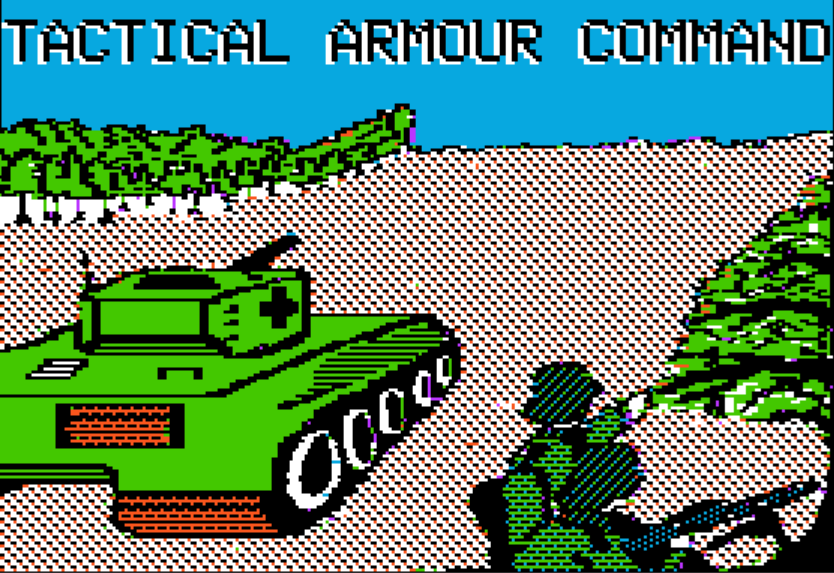
Tactical Armor Command, designed by Ralph Bosson and published by Avalon Hill, USA
First release : May 1983 on Apple II
Tested on : Atari emulator
Total time tested : 5 hours
Average duration of a battle : 1 hour for 8 units vs 8 units.
Complexity: Average (2/5)
Would recommend to a modern player : No
Would recommend to a designer : No
Final Rating : Totally obsolete
Ranking at the time of review : 45/70
The history of Tactical Armor Command comes from email exchanges with Ralph Bosson and a Software Publishing article that he sent me.
Like so many early video game designers, Ralph Bosson bought his first computer – an Apple II – in 1980 to help run his first business. He quickly found out that there was not exactly a lot of software aimed at “residential construction contractors” and learned to code to create the software he needed. Having developed a new skill, he moved to more entertaining ventures. A tabletop wargamer and a motorcycle racer, Bosson wanted to adapt wargames on computer, but without the constraints of the hexagons. Envisioning a game with fluid movement and real line-of-sight, he coded Tactical Armor Command by himself. He then sent the game to various publishers, including SSI and Avalon Hill. Most or all of them were interested, and Ralph Bosson went for Avalon Hill.
Tactical Armor Command was initially designed for Apple II, but it received two other ports : a Commodore 64 port that I did not play and an Atari port. For reasons forgotten by Bosson, the Atari port has a different and more interesting map.

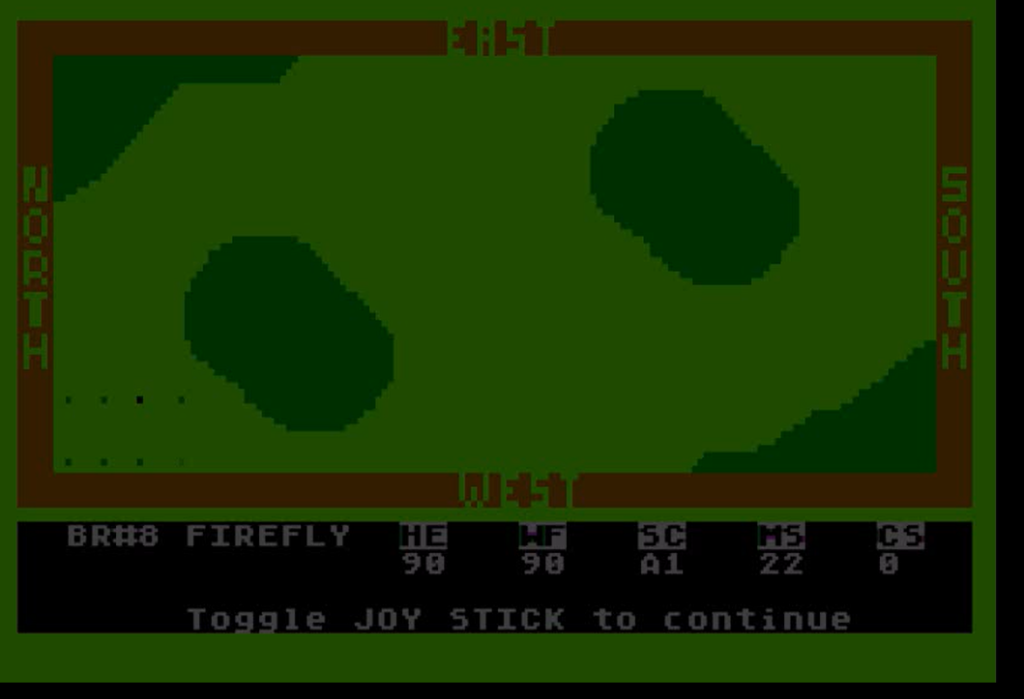
Unfortunately, the game does not leverage Atari’s smooth scrolling, which had become standard by 1983. Even the grognard Paris in Danger by Avalon Hill scrolled seamlessly – but TAC still requires you to type the name of the quadrant you want to look at.
Almost all my real games were on Atari, so the review is for that platform.
A. Immersion
Very poor. In 1983, reviewers praised by the quality of the graphics and the overall realism of the game – the rotating turret in particular impressed everyone. In one of his emails to me, Ralph Bosson recalls : “Mr. Steve Wozniak asked to demo T.A.C. on an Apple II computer. After playing for a period, he looked up at me and said: “I didn’t know the computer could do this.” He was referring to the animation of tank motion with turrets transversing the tank.”
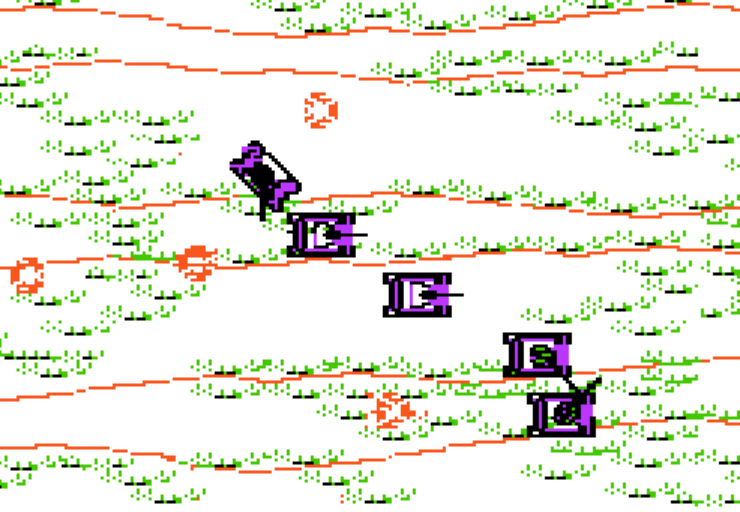
But of course, this was 1983. For a modern gamer, the graphics are dated and the vehicles all look the same.
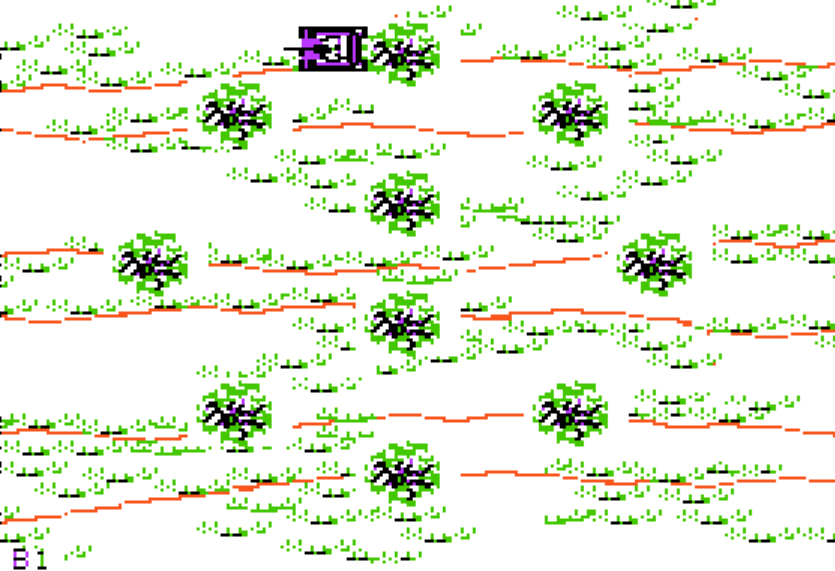
Similarly, two different reviews testify that the sound was considered particularly immersive on Apple II, provided one had a Mockingboard. I can’t tell whether the comments were genuine or if they were hidden ads, but I have to admit the explosions are particularly snappy, and would not feel out of place in a modern game. The rest – not so much. Still, this is the first game so far with good explosion sounds.
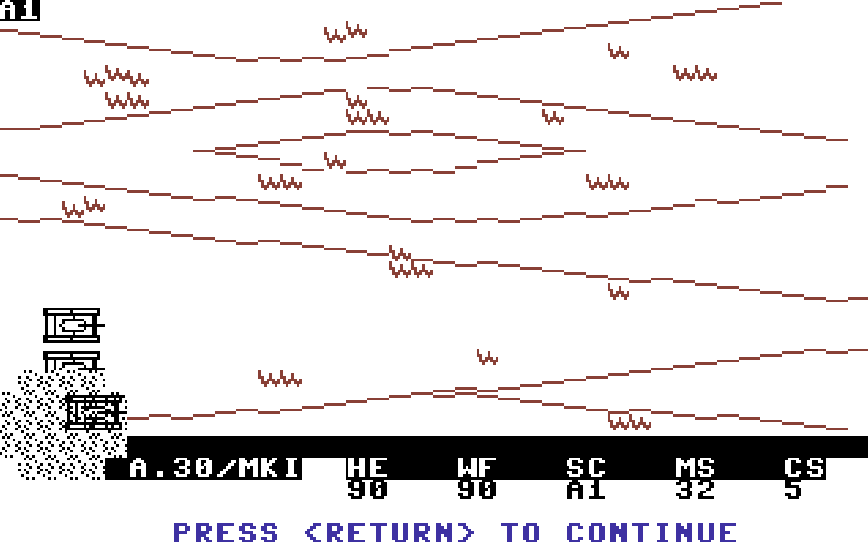
Final note : the manual is well-written and has short descriptions for every vehicle :
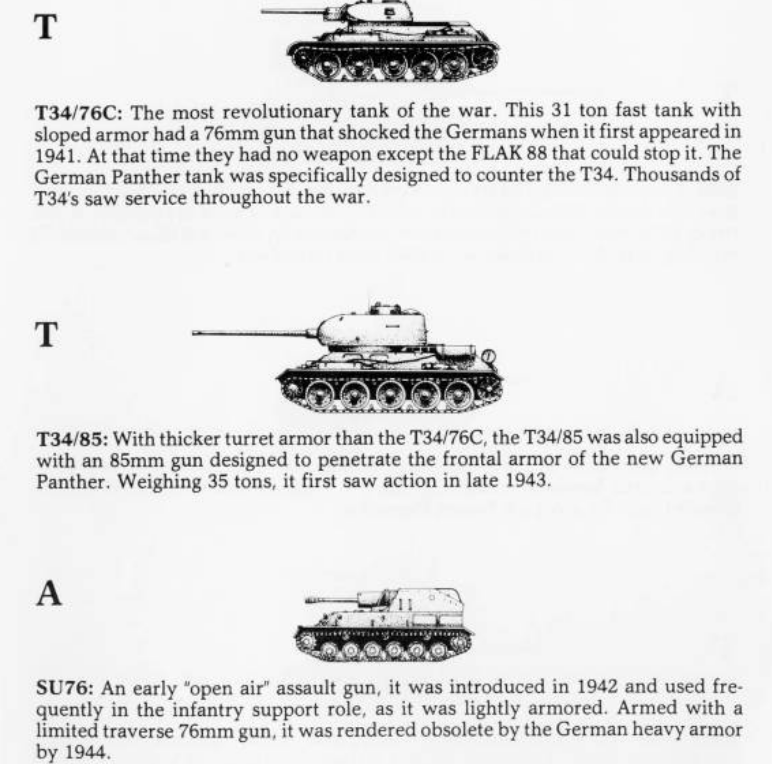
B. UI, Clarity of rules and outcomes
Below terrible. That’s where the game fails – it is as if no effort had been allocated to the user experience.
Let’s go through a turn. At the beginning of a turn, you want to assess the situation. So every turn :
- You need to watch the animation for the indirect fire explosions as seen by every single one of your units. At the beginning of the battle, there is a lot of indirect fire, and a lot of units, so that’s a lot of time watching your computer “rewind” again and again,
- You must manually confirm for every unit that you want to check what it sees (allied or not). The game will then go through every single of those units one after the other.
- On Apple II, the camera does not even move to the units your units detected, the game just gives you direction and distance. Fortunately, this is corrected on Atari which focuses correctly on your target,
- As for your own units, you won’t know the status of your vehicles that were hit by indirect fire – the game will only tell you when it is that unit’s turn,
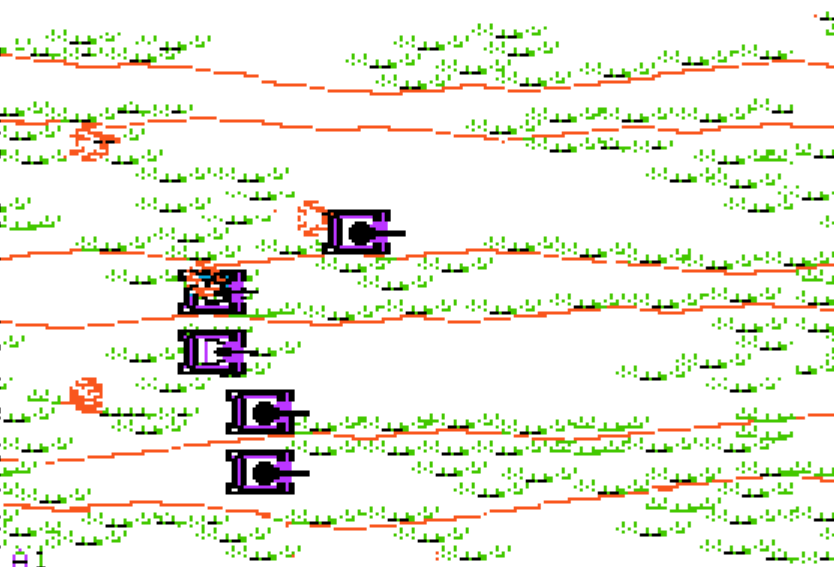
It is now time to move your unit. For vehicles, this is done by first inputting a speed, then controlling the direction of your vehicle as it moves forward. With those awkward controls it is very easy to overshoot wherever you wanted to go (for instance : the edge of a forest) and end your movement in a very visible and very vulnerable state – especially since it is not easy to tell where said forest exactly ends in the first place.
Finally, time to shoot the target :
- On Apple II, you need to type the ID of the target (eg “GE#2”). It is better on Atari as the game lists the potential targets,
- But that’s not over ! On both versions, you need to input the rotation of your turret – totally unnecessary since well, there is only one angle to your target.
Of course, even though the game is turned-based with simultaneous resolution, there is no way to change your order, so that’s another one of the strengths of simultaneous resolution that is not leveraged.
Tactical Armor Command might have some of the less thought-out UI of any game I played. Except for the tendency to overshoot where you want to go, none of it goes away with experience and this alone killed almost all the goodwill I had for the game.
C. Systems
Very poor. Not much to say about this. Tactical Armor Command was the first game to do something that is now the absolute standard : detect the enemy, then shoot at it with a gun big enough to go through the armour, and if the gun is not big enough, find a soft spot. All this without hexagons and with real line-of-sight – though at higher difficulty the AI “cheats” by being invisible even though it is right there in front of your tank, a frustrating “feature”.
One note though : I am not sure whether it comes from tabletop wargames or not, but I find pretty smart to balance infantry by making it resilient. The largest gun in the game will only kill a few men every shot, when any tank can be killed by one lucky shot.
D. Scenario design and balancing
Poor. The game comes with 5 scenarios :
- Meeting engagement : force A meets force B.
- Static Defense : One side starts with “prepared position” (hidden units positioned wherever the player wants) and mines (can only be cleared by infantry). The other side must attack.
- Stalemate : Both sides start with “prepared position” and the mines are positioned by the computer – so no one knows where they are.
- Break-out : Like static defense, except without the mine and the attacker must not destroy the enemy but exit his units. In my limited experience, it ends in the same kind of bloodbath.
- Rear Guard : One player is not-Russian, the other is Russian and has an infinite number of tanks (replacing his losses every turn) – victory is based on points.
The scenarios occur on the same symmetric map, which basically kills diversity. In solitaire, the player chooses the composition of the forces of both sides, which probably allows for interesting situations, but it’s a feature I personally do not like.
The AI is solid, though particularly predictable. It will always do more or less the same, but it will do it well : assault through the middle of the map under the watchful eyes of units hidden in the forest.
E. Did I make interesting decisions ?
A few, but not as much as you would expect given the nature of the map.
F. Final rating
Totally obsolete. I have the same feeling for this game as I had for Legionnaire : I can appreciate how innovative it was at its release, but I cannot overlook its huge flaws as the genre it created is not novel to me, and even what it did well is done much better 40 years later.
Contemporary Reviews
TAC was probably the kind of game that wargamers were looking forward to, and upon its release, pretty much every contemporary review insisted on the strengths. Softalk in August 1983 : “Graphics and sounds effects are first rate […] The attention to detail is awe inspiring […] TAC is a superb entry from Avalon Hill“. This assessment was shared by Softline in its very short review in November 1983 and by the generalist Electronic Games in May 1984 . The latter commented specifically on the “real-time” controls : “The first few games, this reviewer hated this method of moving […] Now, I wish other such games had this feature“
The Byte review in February 1984 is particularly interesting. Jerry Pournelle would later be the lone dissonant voice on Chris Crawford’s Legionnaire (in a May 1984 review), calling it “an arcade game masquerading as a game of strategy“. But in February 1984 he made” TAC his “game of the month”, before handing the review to his son Alexander “with assistance from Richard (13) and Phillip (15)”. After a first potshot “Tactical Armor Command […] is definitely an Avalon Hill game right from its rules through its playability. It even has the old Avalon Hill rule gaps – for instance the game says “fire suppressed”, though the rule book does not mention what that is“), and then another (“Like any other Avalon Hill game, there are endearing foibles as well as just dumb mistakes“), the review reads very similarly to mine, with complaints about the UI, about the lack of scenario and terrain, about the AI making you choose its own units and finally about the fact that “the computer could do a lot more note-taking for you“. The only difference with my review is in the conclusion : the conclusion of the reviewers is that “the game is fun and refreshingly different.
Finally, Computer Gaming World. They should have loved the game, but they did not. In October 1983, reviewer Dick Richards is not impressed, being frustrated in particular by the difficult real-time control of units. His conclusion sounds like something you would say if you were forced to praise something you really do not like: “I found TAC to be an enjoyable and relatively accurate representation of individual armored combat, and one which I will continue to play, on occasion, for quite a while.” Having received the review in advance, Avalon Hill immediately sent a letter to the editor, appended to the review. I quote it in full :
ED. NOTE — Mike Cullum, Director of Software at Avalon Hill Microcomputer Games, indicates that the problem of tank movement as explained in David Long’s review is a matter of “practice”. After a period of learning, players can solve the problems of movement. He said that one reason for including the fast action movement was to put the player in a “live” stress producing situation in which mistakes are made by beginners and are avoided by veterans. Cullum also told us that TAC is the first in a series of games using the TAC system. Tactical armor, both WWII and modern, as well as a divisional level Civil War game are subjects being explored. Future releases will have more emphasis on infantry, better movement systems, and maps which center on units. Cullum says that comments from players of their games are always encouraged.
Two things are incorrect in this note. The first one is that the editors framed the wrong man (the review was not written by David Long). The second one is that there was never any “series of games using the TAC system”. But Ralph Bosson would come back to WW2 with Under Fire! in 1985, another game critically acclaimed and this time without any reservation.
I recently updated the Missing Games & Manuals section. Thanks to Hoeksmas, Jklas and Paul Hagström who found a good chunk of the previous list of lost manuals.
Commenter Porkbelly has done a lot of research on Epyx New World (the lowest-rated game of my blog). I added them at the end of my review of New World. Porkbelly also recreated a manual including all the tables, variables, etc found in the code. Having it beforehand would not have made my experience of playing New World great, but it would have made it better.